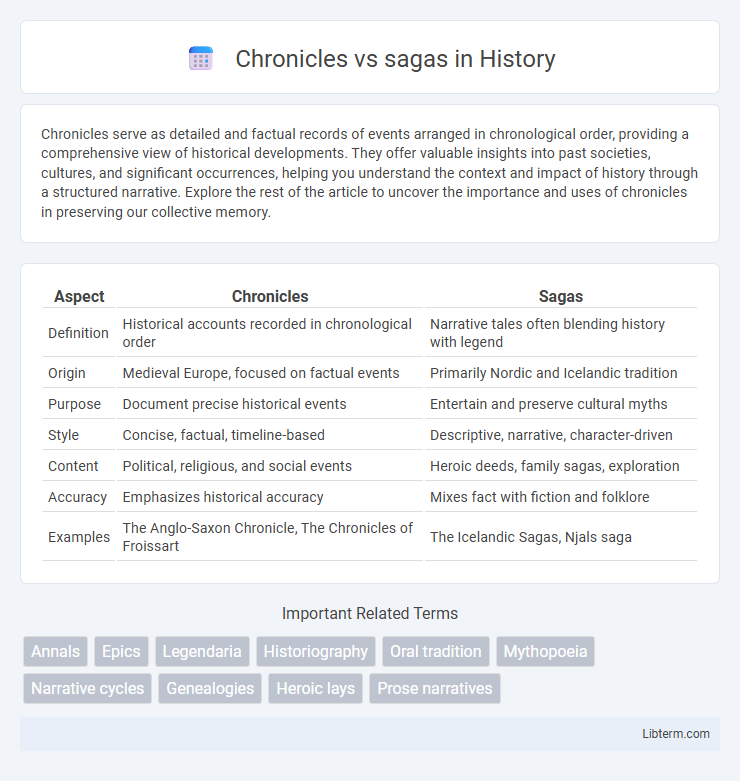Chronicles serve as detailed and factual records of events arranged in chronological order, providing a comprehensive view of historical developments. They offer valuable insights into past societies, cultures, and significant occurrences, helping you understand the context and impact of history through a structured narrative. Explore the rest of the article to uncover the importance and uses of chronicles in preserving our collective memory.
Table of Comparison
| Aspect | Chronicles | Sagas |
|---|---|---|
| Definition | Historical accounts recorded in chronological order | Narrative tales often blending history with legend |
| Origin | Medieval Europe, focused on factual events | Primarily Nordic and Icelandic tradition |
| Purpose | Document precise historical events | Entertain and preserve cultural myths |
| Style | Concise, factual, timeline-based | Descriptive, narrative, character-driven |
| Content | Political, religious, and social events | Heroic deeds, family sagas, exploration |
| Accuracy | Emphasizes historical accuracy | Mixes fact with fiction and folklore |
| Examples | The Anglo-Saxon Chronicle, The Chronicles of Froissart | The Icelandic Sagas, Njals saga |
Understanding Chronicles and Sagas: Key Differences
Chronicles are concise historical records that document events in chronological order, emphasizing factual accuracy and concrete details. Sagas are narrative-driven tales rooted in oral tradition, blending historical facts with myth, legend, and cultural values, often focusing on heroic figures and family lineages. Understanding the distinction between these texts requires recognizing chronicles as objective accounts and sagas as literary stories that preserve cultural identity and social norms.
Historical Context: Origins of Chronicles and Sagas
Chronicles originated in medieval Europe as detailed, year-by-year accounts documenting historical events, often maintained by monks or clerics to preserve religious and political history. Sagas emerged in medieval Iceland around the 13th century, blending oral tradition with literary craftsmanship to narrate heroic exploits, genealogies, and cultural myths of Norse and Icelandic society. Both forms serve as vital historical sources but reflect distinct cultural contexts: chronicles emphasizing chronological accuracy, while sagas prioritize storytelling and cultural identity.
Literary Structure: How Chronicles and Sagas Are Composed
Chronicles are composed as factual, chronological records of events organized by date or year, emphasizing accuracy and temporal sequence. Sagas employ a narrative structure that blends historical facts with legendary elements, featuring episodic storytelling and character-driven plots. The literary structure of chronicles is linear and documentary, whereas sagas are nonlinear and thematic, often incorporating dialogue and detailed descriptions.
Main Themes Explored in Chronicles Versus Sagas
Chronicles primarily explore historical accuracy, political events, and lineage, emphasizing factual recounting of real occurrences and their impact on society. Sagas delve into legendary narratives, focusing on heroism, mythology, and moral lessons, often blending historical kernels with fictional embellishments. The themes in chronicles revolve around documentation and preservation of history, whereas sagas emphasize cultural identity and heroic virtues.
Notable Examples: Famous Chronicles and Sagas
The Anglo-Saxon Chronicle and the Chronicle of Froissart stand out as famous examples of medieval chronicles documenting historical events year by year. In contrast, the Icelandic sagas such as the Saga of Egil Skallagrimsson and the Laxdaela Saga provide rich narrative accounts blending history and legend centered on family lineage and heroic deeds. Both forms have significantly contributed to understanding medieval European history and culture through their distinct storytelling methods.
Role of Authors and Narrators in Chronicles and Sagas
Chronicles typically involve authors who act as objective recorders of historical events, aiming to provide accurate, chronological accounts with minimal personal interpretation. In contrast, sagas feature narrators who blend historical facts with cultural myths, often incorporating personal or communal perspectives to enhance storytelling and convey moral lessons. The distinct roles of authors and narrators in chronicles and sagas influence the reliability, style, and purpose of these literary forms within historical and cultural contexts.
Cultural Impact: Chronicles and Sagas Through History
Chronicles have preserved historical and cultural records by systematically documenting events, shaping national identities through factual narratives often commissioned by rulers or religious institutions. Sagas, rooted in oral tradition, emphasize heroic tales and folklore that transmit societal values and collective memory, particularly in Nordic and Icelandic cultures. Both forms influenced literature and cultural heritage by blending history with myth, reinforcing community cohesion and cultural continuity across generations.
Storytelling Techniques: Narrative Styles Compared
Chronicles use a straightforward, chronological narrative style focused on factual recording of events, emphasizing accuracy and linear progression. Sagas employ a more dramatic, thematic approach, blending oral tradition with imaginative storytelling to highlight heroic deeds and character development. The contrast lies in chronicles' objective tone compared to sagas' rich, evocative language and narrative complexity.
Preservation and Transmission: From Oral Tradition to Written Text
Chronicles and sagas differ significantly in their preservation and transmission, with sagas primarily rooted in oral tradition before being transcribed into written texts, capturing the cultural and historical narratives of Norse societies. Chronicles, by contrast, are typically composed as contemporary written records by historians or monks, providing a more systematic and factual account of events. The transition from oral to written forms in sagas often introduces elements of myth and legend, while chronicles prioritize chronological accuracy and documented evidence.
Relevance Today: Chronicles and Sagas in Modern Literature
Chronicles provide factual, chronological accounts of historical events, offering a foundation for modern historical fiction and nonfiction narratives, while sagas contribute richly to contemporary fantasy and mythological storytelling through their emphasis on heroism and cultural identity. Writers today blend chronicle accuracy with saga's narrative flair, creating immersive worlds that resonate with readers seeking both authenticity and epic adventure. The continued relevance of chronicles and sagas underscores their vital role in shaping literary genres and preserving cultural heritage in modern literature.
Chronicles Infographic

 libterm.com
libterm.com